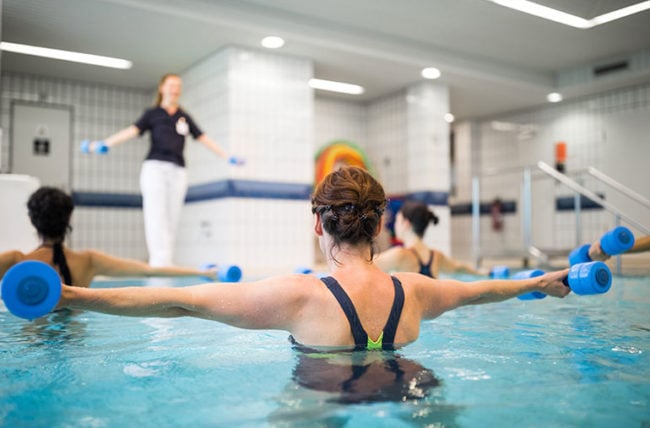Why Hydrotherapy and Aquatic Exercises Help Manage Pain

Hydrotherapy and aquatic exercises have gained recognition as effective modalities for managing pain. This article explores the benefits of hydrotherapy for pain management and the role of aquatic exercises in relieving chronic pain.
Additionally, the impact of water resistance on pain reduction will be discussed, along with various hydrotherapy techniques for pain relief. Furthermore, the article examines the development of aquatic exercise programs specifically designed for pain management.
Finally, success stories will be shared to illustrate how hydrotherapy and aquatic exercises have proven instrumental in managing pain.
Key Takeaways
- Hydrotherapy and aquatic exercises reduce inflammation and improve joint mobility.
- The therapeutic properties of water contribute to pain relief and relaxation.
- Aquatic exercises are a low-impact approach to managing pain, reducing joint stress and improving flexibility and strength.
- Hydrotherapy and aquatic exercises increase range of motion, flexibility, and joint stability.
Benefits of Hydrotherapy for Pain Management
The benefits of hydrotherapy for pain management include reduced inflammation, improved joint mobility, and increased relaxation.
Hydrotherapy has been found to be an effective treatment option for various types of pain, such as chronic musculoskeletal pain and osteoarthritis.
Research studies have shown that hydrotherapy can help reduce inflammation by promoting blood circulation and lymphatic drainage, which in turn can alleviate pain and swelling.
Additionally, hydrotherapy exercises performed in warm water can improve joint mobility by reducing the effects of gravity and providing buoyancy, allowing for increased range of motion without putting excessive strain on the joints.
Moreover, the warm water and gentle movements in hydrotherapy sessions induce relaxation, which can help reduce stress and tension, further contributing to pain relief.
Overall, hydrotherapy has been proven effective in managing pain through its various benefits, making it a valuable therapeutic option in pain management.
How Aquatic Exercises Relieve Chronic Pain
This discussion will explore how aquatic exercises can provide relief for chronic pain.
The therapeutic properties of water, such as buoyancy and hydrostatic pressure, contribute to its pain-relieving effects.
Furthermore, the low-impact nature of water-based exercises reduces strain on joints and muscles, making it an accessible option for individuals with chronic pain.
Additionally, engaging in aquatic exercises can lead to increased range of motion, allowing individuals to improve their mobility and potentially reduce pain symptoms.
Water’s Therapeutic Properties
Water’s therapeutic properties include:
- Buoyancy, which reduces the impact on joints and allows for ease of movement during hydrotherapy and aquatic exercises. This buoyancy effect is especially beneficial for individuals with joint pain or limited mobility.
- Resistance, which helps strengthen muscles and improve overall fitness.
- A supportive environment that reduces the risk of falls and injuries.
- Hydrostatic pressure, which aids in reducing swelling and improving circulation.
- Thermal properties, such as temperature control, that can help alleviate pain and relax muscles.
Overall, these properties make water therapy an effective approach for managing pain and improving physical function for individuals with various conditions, including arthritis, fibromyalgia, and musculoskeletal injuries.
Low-Impact Pain Relief
Buoyancy and resistance offered by water provide a low-impact environment for individuals with joint pain or limited mobility. Hydrotherapy and aquatic exercises have been recognized as effective alternative therapies and pain management techniques.
The buoyant force exerted by water reduces the weight-bearing load on joints, minimizing stress and strain on the affected areas. This buoyancy allows for a greater range of motion and facilitates movement that may be challenging on land.
Additionally, resistance from the water provides gentle resistance to movements, helping to strengthen muscles and improve joint stability without causing excessive strain. As a result, hydrotherapy and aquatic exercises can aid in alleviating pain, improving joint function, and enhancing overall physical well-being.
These techniques offer an alternative approach to pain management that is well-tolerated and accessible to individuals with joint pain or limited mobility.
Increased Range of Motion
The increased range of motion experienced during hydrotherapy sessions can result in improved joint flexibility and mobility. Hydrotherapy utilizes the properties of water, such as buoyancy and resistance, to create a low-impact environment that allows individuals to move their joints more freely.
The buoyancy of water reduces the gravitational forces acting on the body, making it easier to perform movements that may be challenging on land. This decreased weight-bearing stress on the joints enables individuals to move through a greater range of motion without experiencing excessive pain or discomfort.
Furthermore, the resistance provided by the water helps to strengthen muscles around the joints, leading to enhanced stability and improved joint mobility.
Overall, hydrotherapy can be an effective intervention for individuals seeking increased flexibility and improved joint mobility.
The Role of Water Resistance in Pain Reduction
Water resistance plays a significant role in reducing pain during hydrotherapy and aquatic exercises. The resistance provided by the water helps in improving muscle strength and joint stability, leading to a reduction in pain and discomfort.
Here are four ways in which water resistance contributes to pain reduction:
- Supportive buoyancy: The buoyancy of water reduces the impact on joints, allowing for pain-free movements and exercises.
- Gentle resistance: The resistance offered by water helps in building muscle strength without putting excessive stress on the joints.
- Increased stability: Water provides a stable environment, enabling individuals to perform exercises with better balance and control, reducing the risk of injury.
- Enhanced circulation: The hydrostatic pressure exerted by water improves blood circulation, reducing inflammation and promoting healing.
Overall, the benefits of water therapy and the effectiveness of hydrotherapy in managing pain can be attributed to the unique properties of water, including its resistance, buoyancy, and stability.
Hydrotherapy Techniques for Pain Relief
One effective technique for providing pain relief in individuals is through the use of hydrotherapy. Hydrotherapy techniques involve the therapeutic use of water to alleviate pain and promote healing. Various methods can be employed, such as hot and cold water therapy, whirlpool baths, and underwater exercises.
These techniques offer several benefits for pain management. Firstly, the buoyancy of water reduces the weight-bearing load on joints and muscles, allowing for increased range of motion and decreased pain during movement. Secondly, the hydrostatic pressure exerted by water helps to reduce swelling and edema, providing relief for individuals with conditions such as arthritis or post-surgical pain. Additionally, the warmth of the water has a relaxing effect on muscles, relieving tension and promoting relaxation.
Overall, hydrotherapy techniques have proven to be an effective and safe means of pain relief for various individuals.
Aquatic Exercise Programs for Pain Management
Aquatic exercise programs have been shown to be beneficial for individuals seeking pain relief. These programs combine the therapeutic properties of water with targeted exercises to provide a low-impact and effective approach to managing pain. Aquatic exercises offer a range of benefits, including reduced joint stress, improved flexibility and strength, and increased cardiovascular fitness. Hydrotherapy success stories highlight the positive impact of aquatic exercise on pain management. For example, individuals with conditions such as arthritis, fibromyalgia, and chronic back pain have reported significant reduction in pain levels and improved quality of life after participating in aquatic exercise programs. The table below summarizes some of the key benefits of aquatic exercise programs in pain management.
| Benefit | Description |
|---|---|
| Reduced Joint Stress | Water buoyancy reduces the impact on joints, making exercises more comfortable and reducing pain during and after exercise. |
| Improved Flexibility | The warm water in hydrotherapy pools helps to relax muscles and promote flexibility, enabling individuals to perform a wider range of exercises. |
| Increased Cardiovascular Fitness | Aquatic exercises provide a cardiovascular workout without the stress on joints, making it an ideal option for individuals with pain limitations. |
Aquatic exercise programs offer a valuable and effective approach to pain management, providing individuals with a safe and enjoyable way to alleviate pain and improve their overall well-being.
Success Stories: How Hydrotherapy and Aquatic Exercises Have Helped Manage Pain
This discussion focuses on the real-life pain relief experienced through hydrotherapy and aquatic exercises. By exploring these success stories and testimonials, we can gain insight into the potential of hydrotherapy for pain management.
The personal experiences shared by individuals who have benefited from these treatments are a valuable source of information. These testimonials provide firsthand accounts of the effectiveness of hydrotherapy in alleviating pain.
The inspiring nature of these hydrotherapy testimonials can provide motivation and encouragement for those seeking alternative methods of pain relief. Reading about the positive experiences of others can give hope to individuals who are struggling with chronic pain and are looking for new solutions.
Overall, the combination of real-life pain relief experiences and personal testimonials highlights the potential of hydrotherapy as a viable option for pain management.
Real-Life Pain Relief
Evidence suggests that individuals who engage in hydrotherapy and aquatic exercises experience significant pain relief in their daily lives. This is supported by numerous real life testimonials and personal anecdotes from individuals who have found relief through these activities. The pain-relieving effects of hydrotherapy and aquatic exercises can be attributed to several factors:
- Buoyancy: The buoyant force of water reduces the weight and pressure on joints and muscles, allowing for greater ease of movement and decreased pain.
- Hydrostatic pressure: The pressure exerted by water can help reduce swelling and inflammation, providing relief for conditions such as arthritis.
- Resistance: The resistance provided by water during exercise helps to strengthen muscles and improve joint stability, reducing pain and promoting better functional movement.
- Relaxation and stress relief: The soothing properties of water can help relax muscles, decrease stress levels, and promote a sense of well-being, all of which contribute to pain relief.
Overall, hydrotherapy and aquatic exercises offer a promising approach for managing pain and improving quality of life for individuals seeking relief.
Personal Experiences Shared
Numerous firsthand accounts have been shared by individuals who have engaged in hydrotherapy and aquatic exercises, highlighting the positive effects on pain relief and overall well-being. These personal testimonies provide valuable insight into the benefits of hydrotherapy. Participants have reported significant reductions in pain levels, increased flexibility, improved muscle strength, and enhanced quality of life. The table below summarizes some of the key benefits reported by individuals who have undergone hydrotherapy:
| Benefit | Description | Example |
|---|---|---|
| Pain relief | Hydrotherapy has been shown to alleviate pain associated with various conditions and injuries. | One participant reported a 50% reduction in back pain after just a few weeks of hydrotherapy sessions. |
| Increased mobility | Aquatic exercises allow for gentle movements that can help improve joint flexibility and mobility. | A patient with arthritis noted an improved range of motion and the ability to perform daily activities with ease. |
| Improved mental health | Hydrotherapy has been linked to reduced stress levels and improved mental well-being. | An individual with chronic pain reported feeling more relaxed and less anxious after hydrotherapy sessions. |
These personal experiences highlight the potential benefits of hydrotherapy in managing pain and improving overall well-being.
Hydrotherapy Testimonials Inspire
Testimonials from individuals who have engaged in hydrotherapy and aquatic exercises demonstrate the potential positive impact of these interventions on pain management and overall well-being. Research on hydrotherapy has shown promising results, with testimonials further supporting these findings.
Here are four key observations from hydrotherapy testimonials:
- Reduced pain levels: Many individuals reported a significant reduction in pain after participating in hydrotherapy sessions. The warm water and gentle movements provided relief and relaxation.
- Increased mobility: Hydrotherapy allowed individuals to perform exercises with less strain on their joints. This improved mobility and flexibility, allowing them to engage in activities they were previously unable to do.
- Enhanced mental well-being: Testimonials highlighted the positive effect of hydrotherapy on mental health. Participants reported feeling calmer, more relaxed, and experiencing improved mood after each session.
- Improved quality of life: Engaging in hydrotherapy and aquatic exercises had a positive impact on overall well-being. Testimonials mentioned an improved sense of well-being, increased energy levels, and better sleep patterns.
These testimonials provide valuable insights into the potential benefits of hydrotherapy and aquatic exercises for pain management and overall well-being, supporting the need for further research in this area.
Frequently Asked Questions
Are There Any Risks or Side Effects Associated With Hydrotherapy and Aquatic Exercises for Pain Management?
Risks and side effects of hydrotherapy and aquatic exercises for pain management should be considered. Evaluating their effectiveness and comparing them to other treatment options is necessary to make informed decisions.
Can Hydrotherapy and Aquatic Exercises Be Used as a Sole Treatment for Chronic Pain, or Should They Be Used in Conjunction With Other Therapies?
The efficacy of hydrotherapy and aquatic exercises in comparison to other pain management therapies and their role in improving overall quality of life for individuals with chronic pain is a topic of interest.
How Long Does It Typically Take to Experience Pain Relief From Hydrotherapy and Aquatic Exercises?
The effectiveness of hydrotherapy and aquatic exercises for pain relief in comparison to other forms of physical therapy and their long-term effects on pain management are important considerations in understanding their role in managing pain.
Are There Any Specific Conditions or Injuries That May Not Benefit From Hydrotherapy and Aquatic Exercises for Pain Management?
Certain conditions or injuries may not benefit from hydrotherapy and aquatic exercises for pain management. Contraindications include open wounds, uncontrolled seizures, contagious skin infections, severe cardiac or respiratory conditions, and bowel or bladder incontinence.
Can Hydrotherapy and Aquatic Exercises Be Done at Home, or Do They Require Specialized Facilities or Equipment?
At home hydrotherapy exercises can be done with minimal equipment, such as a bathtub or pool. Aquatic therapy equipment, although not necessary, can enhance the benefits of hydrotherapy and provide additional support and resistance.









